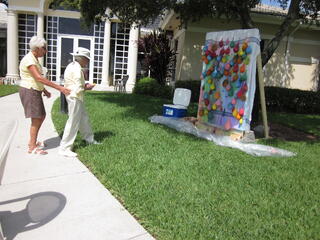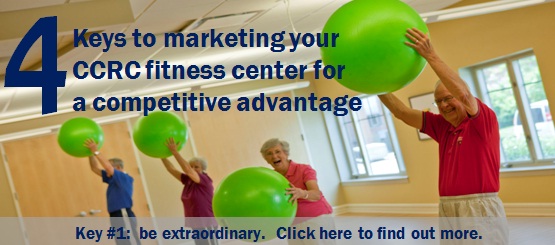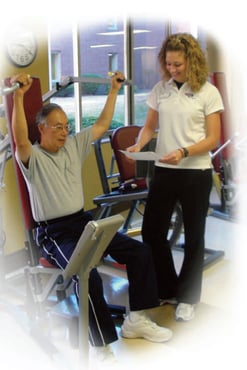In my work with life plan communities across the U.S., I’ve seen resident  wellness programs and services come in all shapes and sizes, and it's rare these days for communities NOT to promote some type of "wellness" programming for their residents. Clearly, communities are getting the message about how important resident well-being really is for both the resident and the business.
wellness programs and services come in all shapes and sizes, and it's rare these days for communities NOT to promote some type of "wellness" programming for their residents. Clearly, communities are getting the message about how important resident well-being really is for both the resident and the business.
Resources like the National Whole Person Wellness survey that can guide and inform both strategic and tactical decisions for a community wellness initiative are becoming more commonly available. Similarly, the swell around opportunities like the International Council on Active Aging’s focus on Active Aging Week have sparked creative programming for older adults to engage in vibrant living.
For all of the fantastic diversity in wellness programming, resources, and opportunities available in senior living settings, there seems to be a consistent theme for many providers. They pull together initiatives only to have the same core group of residents participate. Simply put, there is a lack of robust resident engagement in the programs put forward by resident life coordinators.
It’s not an all-inclusive list, but what I’ve offered below represents some of the most common challenges I have seen in communities where NIFS provides staffing services or where I’ve offered wellness program consulting. If you find yourself nodding your head in affirmation as you read, it might be time to take a fresh look at what you’re offering and how you’re providing it.
Reason 1: Community champions were not tapped as a promotional avenue for your programming.
Trying a new group fitness class, sampling from a new healthy menu, or participating in a new wellness initiative can be daunting if you’ve never done it before. There’s nothing like a personal invitation from a neighbor or trusted friend to help nudge you toward trying something new.
If you’re not working with your top resident participants to capitalize on their success as a tool for inviting new residents to engage, you’re missing out. Personal invitation, testimonials, and other individual connection can be very successful tools for attracting other, less active residents toward wellness programming.
- Capture testimonials in resident newsletters and on community bulletin boards/CCTV.
- Talk to specific residents prior to launching a new initiative and ask them to invite their friends to join them. Tell them why you think their personal invitation is so important. Perhaps suggest specific residents they could connect with for the activity.
- Build a “refer a friend” component into your next activity challenge.
Reason 2: Power grabs and silos are overshadowing what’s really possible at your community.
No one wins when the activity director, the physical therapy group, and the fitness manager are vying for control of programs, spaces, and resident loyalty. Establishing a collaborative approach across all stakeholders creates a more rich experience for the residents.
- Activities staff should be eager to learn from their fitness director how to fold more exercise and other healthy messages into their standard programming. For what it’s worth, if you’ve done your homework and gotten the right person to direct your fitness center, then he or she is likely also qualified to provide expertise related to whole-person wellness.
- The fitness director and the therapy department should be eagerly working together on a cross-referral program that supports appropriate therapy for residents in need and fitness program participation to maintain the positive work completed in therapy.
- Programs and events should periodically jive with marketing events/efforts so that the community can maximize resources to serve their current residents and the prospects they want to reach.
Reason 3: You forgot to ask the residents what they want to learn about and how they want to grow.
Communities are practiced at surveying residents, but those surveys typically encompass overall living at the community. Rarely are communities engaged in surveying residents about what their lifestyle expectations are. Even rarer are custom focus groups where much can be learned about resident perspectives on current and future healthful-living offerings.
Reason 4: Volunteerism by residents is overlooked as a strategy to get more done with less staff.
Let’s face it : community financial resources are typically limited, and no one wants to charge residents more to expand services. If you're limited to the staff resources you currently have, consider tapping into occupational wellness by engaging resident volunteers to own some of the community wellness initiatives.
- Walking groups, small-group Bible study, craft or hobby groups, and promotion and health-focused book clubs can all be resident driven.
- You may be able to engage tech-savvy residents to support program data collection and analysis. Who could help you convert the manual attendance records into your software or spreadsheet for later analysis?
Reason 5: Data is king. If you don’t have data, you won’t know what’s working.
If I had a nickel for every time I talked to community professionals who told me they weren’t tracking attendance in their programs, I’d be set for early retirement. Simply, you need to start gathering data on your initiatives. It doesn’t have to be daunting and the numbers don’t have to be confusing. But if you keep burying your head in the sand on numbers because you’re “not good with numbers,” you will forever be left with initiatives that are about as effective as slapping spaghetti against the wall to see what sticks.
- Start small with participation numbers. Take attendance in your group fitness classes to learn which residents are coming and how often. Have residents self-report participation in the next healthy food tasting event, etc.
- Refer to #4 for some support on how to use participation numbers to track trends over time.
- Work with your marketing staff to find out what kinds of numbers they need to market your community’s wellness program, and then determine how to capture that data for them.
What will you do next?
I’m not a fan of change for the sake of change alone. Still, sometimes change is necessary to elevate your offerings for the good of your community. If you’re looking for a little help in evolving your community wellness strategy, visit our consulting page for a free 30 minute consultation.


 You likely receive feedback from residents on how much they enjoy certain group fitness classes or instructors, or perhaps the NuStep in the fitness center. You hear it in passing comments like, “Don’t get rid of the yoga instructor,” or “We need another NuStep.” Those comments provide great feedback as part of your overall assessment of the fitness program. But beyond those individual preferences, how do you measure the true value of your community fitness program and what it lends to your resident population as well as to your community’s marketing potential?
You likely receive feedback from residents on how much they enjoy certain group fitness classes or instructors, or perhaps the NuStep in the fitness center. You hear it in passing comments like, “Don’t get rid of the yoga instructor,” or “We need another NuStep.” Those comments provide great feedback as part of your overall assessment of the fitness program. But beyond those individual preferences, how do you measure the true value of your community fitness program and what it lends to your resident population as well as to your community’s marketing potential?

 wellness programs and services come in all shapes and sizes, and it's rare these days for communities NOT to promote some type of "wellness" programming for their residents. Clearly, communities are getting the message about how important resident well-being really is for both the resident and the business.
wellness programs and services come in all shapes and sizes, and it's rare these days for communities NOT to promote some type of "wellness" programming for their residents. Clearly, communities are getting the message about how important resident well-being really is for both the resident and the business.
 Of course, it’s horribly self-serving for us to say that staffing your onsite fitness center and wellness initiatives isn’t a DIY (do it yourself) project. We’re not above shameless self-promotion, but the truth is, the consequences of making fitness center management a DIY initiative can be costly. Read on to learn NIFS top three reasons to outsource fitness center management of your retirement community or worksite fitness center.
Of course, it’s horribly self-serving for us to say that staffing your onsite fitness center and wellness initiatives isn’t a DIY (do it yourself) project. We’re not above shameless self-promotion, but the truth is, the consequences of making fitness center management a DIY initiative can be costly. Read on to learn NIFS top three reasons to outsource fitness center management of your retirement community or worksite fitness center. 
 In my last post, I explained that functional capacity is exercising in a way that improves the ability to perform activities of daily living. In this post I look at how this concept is being used in senior fitness classes and corporate fitness programs--in place of more traditional but less efficient training.
In my last post, I explained that functional capacity is exercising in a way that improves the ability to perform activities of daily living. In this post I look at how this concept is being used in senior fitness classes and corporate fitness programs--in place of more traditional but less efficient training.
 In previous posts, I have talked about functional capacity and how corporate fitness programs and senior fitness classes are using this concept to improve workouts and make them more beneficial to everyday life.
In previous posts, I have talked about functional capacity and how corporate fitness programs and senior fitness classes are using this concept to improve workouts and make them more beneficial to everyday life.